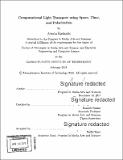Computational light transport using space, time, and polarization
Author(s)
Kadambi, Achuta
DownloadFull printable version (48.43Mb)
Other Contributors
Program in Media Arts and Sciences (Massachusetts Institute of Technology)
Advisor
Ramesh Raskar.
Terms of use
Metadata
Show full item recordAbstract
Understanding how light travels through macroscopic scenes can transform autonomous driving, medical imaging and consumer photography. Unfortunately, this understanding is difficult to achieve: trillions of light paths are measured by millions of pixels. The framework of computational light transport was introduced to model this complex interaction between light and matter in a tractable space. In this thesis, we study new methods to invoke space, time, and polarization into a computational light transport framework. First, we study how probing the time dimension enables cameras to separate bounces from multiple light paths. Our solutions are inspired by prior work on multipath in wireless and telecommunications. We then invoke both time and space to provide the first provable bound on resolution for seeing around corners or through scattering media. Finally, we jointly invoke space, time, and polarization to propose an ultra-high quality form of 3D imaging. This thesis contributes a few analytical theories, including: (1) provable bounds on multipath separation; (2) provable bounds on seeing around corners; and (3) proof of shape reconstruction from polarimetric measurements. The thesis also contributes new applications that span: (a) micron-scale 3D cameras; (b) real-time object tracking around corners; and (c) single-shot computational relighting of images. Future applications encompass equipping self-driving cars the ability to see through fog, or enabling doctors to see deeper inside the body using light.
Description
Thesis: Ph. D., Massachusetts Institute of Technology, School of Architecture and Planning, Program in Media Arts and Sciences, 2018. Cataloged from PDF version of thesis. Includes bibliographical references (pages 261-273).
Date issued
2018Department
Program in Media Arts and Sciences (Massachusetts Institute of Technology)Publisher
Massachusetts Institute of Technology
Keywords
Program in Media Arts and Sciences ()